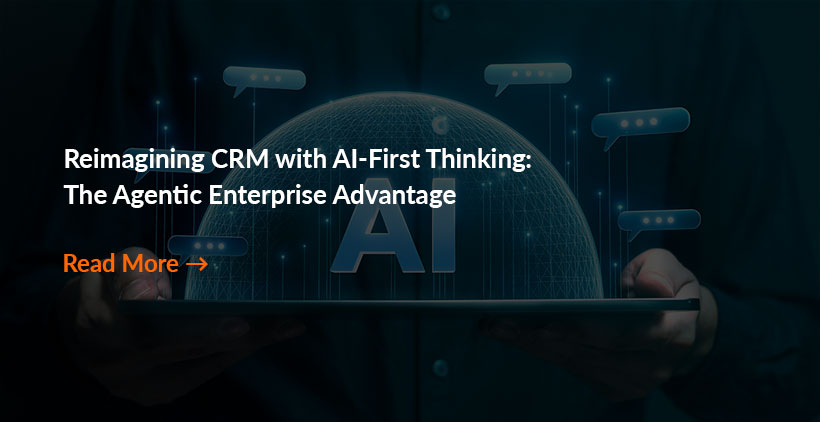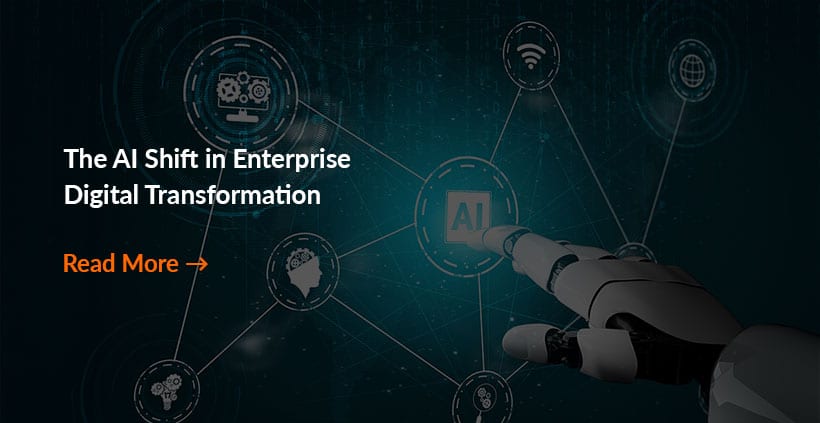
Artificial Intelligence (AI) alters custom applications by automating mundane tasks, streamlining operations, refining customer service, optimizing decision-making, and driving innovation. As AI becomes the key digital transformation technology for industries, it has also built a foundation for data analytics to nurture informed decision-making, orchestrate business outcomes, and define success.
Applying AI and Machine Learning in Data Analytics
Massive and highly complex datasets spout actionable insights for global companies today. AI and machine learning algorithms cut through the noise by identifying key patterns, trends, and outliers to give analysts the clarity needed to drive tangible impact. When used for predictive modeling and automated report generation, they allow businesses to take proactive actions aligned with market demand. Besides improving operational efficiency, AI-powered data analytics uncovers the risks and opportunities that are not easy to detect using traditional methods. With AI-integrated analytics, data insights are more accessible. AI chatbots and conversational analytics platforms are powered by natural language processing, enabling non-technical teams to explore metrics and make informed decisions.
Using AI in Data Analytics
By investing in quality data and the right tools, businesses can reap several benefits from AI-driven data analytics. Some ways to utilize it include:

Code Generation and Error Debugging
Many organizations are likely to use AI to generate code or troubleshoot issues in data analysis – this is especially helpful while visualizing big datasets and building machine learning models. GitHub Copilot is a popular coding assistant that suggests code completions, provides context-rich recommendations, and can also generate code in response to natural language prompts. For developers who’ve written some complex code but have problems explaining it in text, AI can comment on it, making it lucid and saving time on tedious documentation. MS Excel users can use Microsoft 365 Copilot to create formulas and macros while handling large data volumes. What’s more, by debugging the exact errors encountered in coding, AI eliminates the time spent searching for the right solutions.
Explaining Insights: Data analytics bring value when an organization can dive deep into information pools and extract clear insights to guide business decisions in the right direction. This is where AI helps. For example, Salesforce’s Tableau adds simple, no-jargon explanations to dashboards in seconds. It enables decision-makers to know the “why, what, how, and when” behind insights with engaging visualizations that can be further explored. With AI-assisted data analytics tools such as Tableau and Microsoft Power BI, businesses get quick answers to strategic questions, including:
- Why did our sales decrease in April?
- Which product variant is most popular in a regional market?
- Which was the best revenue quarter in the last fiscal year?
AI capabilities being scalable also simplify exploratory data analysis when new datasets enter data analytics projects.

Synthetic Data and Data Imputation
According to Gartner, by 2030, synthetic data will overshadow real data in AI models. As a supplement or alternative to real data, it gives access to well-annotated facts to build vast datasets and extensible AI models tailored for specific use cases. AI-produced synthetic data eliminates privacy concerns and can be used to test and validate algorithms without violating compliance regulations. Businesses can use it to expedite model training, reduce bias in AI models, and improve forecasting accuracy. Quality assurance teams can employ synthetic data to test the functionality of applications. In the financial services industry, such data can simulate market scenarios and evaluate investment strategies without using sensitive details.

Automating Image-Based Data Entry
With its computer vision and machine learning technologies, AI enhances data entry from images, extracting meaningful observations with accuracy and speed. Organizations can automate tasks like image classification, object detection, and facial recognition while avoiding errors and minimizing manual inputs. In seconds, they can transform scanned receipts, documents, and handwritten notes into structured, analyzable data. AI sifts through image data, revealing the highlights and relationships often discernible to human observers. AI can examine complex visuals like X-rays, MRIs, and CT scans in healthcare for quick diagnosis and appropriate treatments. In agriculture, drones can study crop health for optimal care.

Polishing Data Quality for Better Outcomes
AI also improves data analytics through automated data cleaning. It can identify and remediate errors and inconsistencies in data pools, including removing duplicates, correcting typos, flagging outliers, standardizing formats, and ensuring data imputation. AI’s ability to turn messy datasets into reliable assets strengthens the foundations for analytical and predictive models. Businesses get insights faster, make smarter decisions, and reduce their risk of using flawed data. Clean, anomaly-free data with standardized formats reflects the truth to give a strategic advantage to organizations, keeping them competitive, agile, and insight-ready at every step.
Future of Smart Analytics
As datasets become larger and more heterogeneous, AI and machine learning will continue to be indispensable for converting raw data into actionable insights. Their ability to accelerate scanning, predict market shifts, and optimize decision-making will increase industry adoption. Nevertheless, as powerful as AI is, it will not replace the role of the workforce that has been interpreting data for decades. Ethical considerations, business context, and strategic alignment also require human judgment. A synergy between intelligent algorithms and thoughtful human oversight would echo the dynamics of Industry 5.0, where machines and humans collaborate for innovation, resilience, and sustainable impact.




